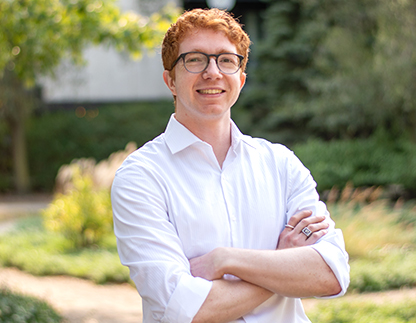I aspire to combine the tools of materials science and engineering with the methods of public health to develop accessible material systems that make communities healthier.”
Alex Evenchik
PhD Candidate in Materials Science and Engineering and Master of Public Health Student

Alex Evenchik is a PhD candidate in the Department of Materials Science and Engineering in the McCormick School of Engineering. He designs and 3D prints muscle-like materials for use in robotics that have the potential to enhance prosthetics, agriculture, and human-machine interaction. Alex is a Ryan Fellowship recipient and a member of the Robotic Matter Lab.
How would you describe your research and/or work to a non-academic audience?
I make materials that mimic muscle but don’t contain cells or other living components. I use these materials to create robots that can better function in our everyday world in an emerging field called soft robotics. More specifically, I work with materials called liquid crystal elastomers (LCEs) that have really exciting properties, such as the ability to move under various stimuli, much like the muscles in our bodies do. I synthesize and 3D print these materials, with the hope of using them to improve various aspects of our society, from prosthetics to agriculture to human-machine interactions.
Tell us what inspired your research and/or work.
Ever since I was young, I have loved animals and have been fascinated by how they explore and adapt to their environments. Animals are able to perform tasks and move in incredible ways that traditional robots simply can’t, and a large part of this gap originates from the fact that these two systems are made of fundamentally different materials. Coming into my PhD, I wanted to create materials that bridge this gap between the built and biological worlds. This inspired my current work, which is focused on creating materials that behave like the biological systems I’ve always been interested in.
How do you unwind after a long day?
I love exercising, talking with my roommates and friends, and exploring the diverse Chicago neighborhoods.
What books are on your bedside table?
There are quite a few! I’m rereading a fantasy series I love called Malazan, starting a series of short stories written by R.K. Narayan that my lab mate gave me, and just finished reading (and airing my frustrations at) Bad Blood about the Theranos scandal.
What inspires you?
I aspire to combine the tools of materials science and engineering with the methods of public health to develop accessible material systems that make communities healthier. This vision is the result of many sources of inspiration: from mentors who showed me the power of combining unexpected disciplines, to conferences that exposed me to the multiplicity of stakeholders that are necessary to develop good public health policy, to study-abroad opportunities where I saw firsthand the challenges of delivering healthcare in remote settings. These mentors and experiences motivated me to pursue a Master's in public health alongside my PhD in order to develop the skills necessary to turn this vision of a healthier world into a reality.
What did you originally want to be when you grew up?
When I was young, I really wanted to be a paleontologist. I loved dinosaurs and checked out every book I could get my hands on at my school library. This love of dinosaurs grew into an appreciation for biology as a whole, which eventually led to the materials I now research.
What advice would you give your younger self or someone considering a similar path?
Throughout undergrad, I was always seeking ways to combine my interest in materials science and engineering with my passion for biology and health. Regardless of where I looked, I couldn’t find a way to combine these two fields in a manner that was satisfying to me, and I was worried that I might never find one. It was only well into graduate school that I realized that the path I was looking for was at the intersection of materials science and public health, and that it was a path that I would have to help forge.
If I had to sum all this up, my advice would be this: It’s okay to be dissatisfied with how things are. Follow that dissatisfaction to identify what it is that you really want. You might find that the thing you want doesn’t exist yet, in which case you have the chance to create something new, which is challenging, but worth it.
Tell us about a current achievement or something you're working on that excites you.
Recently, I have been excited by the work I’ve been doing as one of the Legislative Outreach Chairs for Northwestern University’s Science Policy Outreach Taskforce (SPOT). Through organizing now-annual trips to the Illinois State Capitol to advocate for and support evidence-based policy, we’ve fostered relationships with state legislators and created opportunities for STEM graduate students to use their skills to impact the development of policy.
For example, this year we’ve written documents on the environmental, health, and economic aspects of polystyrene foams (in coordination with a bill focused on banning polystyrene foams in food packaging) and the impact diesel exhaust has on the health of susceptible Chicago populations. I’m really proud of how far we’ve come these past few years, not only building our own capacity to translate scientific knowledge into policy insights, but also fostering excitement and desire at the state for the work that we do.
Publish Date: July 15, 2025
If you know a graduate student, postdoctoral scholar, graduate faculty member, staff member, or a member of our TGS alumni population who would make a great candidate for our TGS Spotlight Series, please complete this brief TGS Spotlight Series Nomination Form.